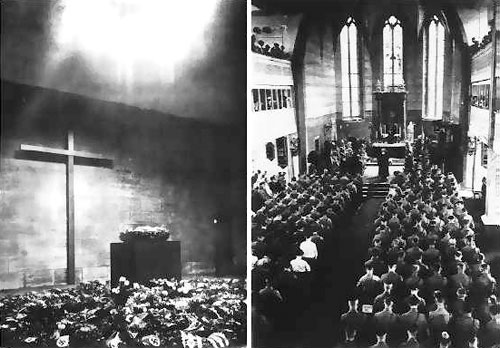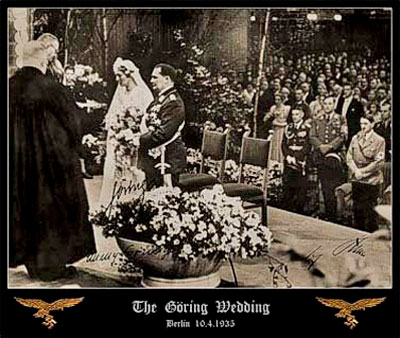|

by hharaldsson
January 4, 2010
from
NewsJunkiePost Website

Gott mit uns -
God with us
Nazi belt buckle
The extent to which the American
Republican Party of 2010 is following in the footsteps of National
Socialism is much debated.
Naomi Wolf’s
The End of America - Letter
of Warning to a Young Patriot offers us “Fascist America in 10 easy
steps.” Without mentioning Christianity specifically, Wolf outlines
in frightening detail what happened in Germany of the 1930s and
shows how it could happen here.
She bases her outline on events which
took place during the presidency of George W. Bush, the man the
Religious Right identified as “God’s chosen” - a return to the old
Christian ideal of rule by divine right.
Both Adolf Hitler and
George W. Bush (and now the
post-Bush Republican Party) enjoyed the ardent - one might say
fanatical - support of conservative Christians. I have argued
elsewhere (Back to the 30’s
- National Socialist and Republican
Discourse) that these similarities are not superficial, but can be
identified at the heart of the discourse and rhetoric employed by
each movement.
I touched in passing there National
Socialism’s relationship with Christianity - my focus was more
political - but here I will examine the religious aspects.
There is no real contradiction in calling Germany a Christian Nation
while denying that epithet to America.
The Old World had a long
history of state religions - exactly what our 18th century
Evangelicals and our Founding Fathers were trying to avoid in the
New World - and it was that reality that drove the Founding Fathers
to draft the First Amendment, thus freeing the new nation from that
evil:
Congress shall make no law respecting an establishment of religion,
or prohibiting the free exercise thereof; or abridging the freedom
of speech, or of the press; or the right of the people peaceably to
assemble, and to petition the Government for a redress of
grievances.
Before the Reformation, Europe was composed of kingdoms, duchies,
principalities and so forth, all of them boasting Christianity as
their state religion.
In 1530 many German states declared their new
state religion to be Protestant. Many of the first settlers in North
America were fleeing religious wars and religious persecution that
arose in this era. I have ancestors on my father’s side who were
French Huguenots, fleeing Catholic persecution in France in the 17th
century.
The people coming to these shores did not want state religion, or
state interference in their religion. They did not want to be told
how to worship or what to believe. But that is entirely contrary to
the European experience.
In 1910 Richard Lempp noted that every German was by birth a member
of the Church of his or her state - either Protestant or Catholic -
just as he or she was a citizen of a state and each of the 26 German
states had its own established Church. This has never been true of
the United States, and we have the First Amendment to thank for
this.
There are no state religions in American states or in the United
States as a whole. The professors of theological faculties were
appointed by the governments of the German states, not by the
Church. German churches were state churches. When a child went to
school, he received 2-12 hours of religious instruction each week
all the way through the end of high school.
They were taught Christian theology, church history and ethics and
during the last two years of one’s education the teaching was done
by pastors, not by school teachers. Participation in state religion
became voluntary only upon graduation.[1]
This is what I mean when I say that
Germany was a “Christian Nation.”
This was the situation up until 1918. It
must be remembered that the National Socialist hierarchy was a
product of this pre-1918 era, as were many of the men of military
age when war came in 1939 (when the class of 1918 would have been
21).

A church full of
Nazis
And Hitler himself disapproved of
secular schools.
On April 26, 1933, during negotiations leading to
the
Nazi-Vatican Concordant, he said:
“Secular schools can never be
tolerated because such schools have no religious instruction,
and a general moral instruction without a religious foundation
is built on air; consequently, all character training and
religion must be derived from faith… we need believing people.”
We have seen the degree to which modern
Republican discourse agrees with Hitler’s summation. Morality, we
are told, is impossible outside of a Christian context; secular
schools cannot be trusted to properly indoctrinate our children.
Richard Lempp updated his study of German religion in 1921,
post-Versailles Treaty, and spoke of the revolution of 1918, which
had the effect of shattering the relationship between Church and
State. Lempp saw as the cause of this separation the Socialists, who
in 1891 in the Socialist Program of Erfurt, had declared that
religion was a private matter.
After the end of the Great War,
“the ministry of public worship and
education, which before the revolution had charge of the
churches, now came into the hands of men who belonged to no
church… in the most important state, Prussia, the
'Kultusminister' was the well-known Adolf Hoffmann, a Berlin
bookseller who for years had opposed both religion and the
churches with malice and contempt,” says Mr. Lempp. “He began by
prohibiting prayer in the Prussian schools and proclaiming the
abolition of all religious instruction.”
Religious instruction was also abolished
in Saxony, Gotha, Brunswick and Hamburg without appeal to special
legislation.
You can see at this point both the beginnings of an understanding of
Church and State relations that would be recognizable
to Americans and also the hostility with which this break is greeted
by Mr. Lempp, himself a German Christian.
But we are also told of the strength of
Christian belief in the new Germany; in the Rhineland, Catholics
threatened to secede if,
“irreligious radicals continued to dominate
the government” and “in northern Germany alone seven million
Protestants signed a protest against the abolition of religious
instruction in schools.”
Again, this situation will seem familiar to readers today. There is
talk of secession and it is in part due to conservative Christian
feeling. Until recently, this is a situation you can never imagine
having occurred in the United States with its long tradition of
separation of Church and State.
In 1919, therefore, the American concept of separation of Church and
State was rejected by German voters - just as it is being rejected
by conservative Christian voters in the United States.
“Rather it was universally demanded
that the church, although now independent of the state, remain 'Volkskirche,' a national church” with the
result that religion continued to be taught in the schools.[2]
The Germany that greeted the rise of
National Socialism was still a Christian nation.
The only real
difference in 1919 was that the church was no longer
state-sponsored, but the states paid the churches an annual annuity
in its place, so the change was cosmetic only.

Nazi Christmas
tree ornaments
It is clear that Germany both before and
after 1919 was overwhelmingly Christian and remained so into
Hitler’s Third Reich.
The people in charge had grown up in a
Christian Germany and the people who followed their leaders had
grown up either in the same period or in the early to mid-20s. It
was both Protestants and Catholics who voted the National Socialists
into power, not Pagans, not feminists, not homosexuals, not
secular-minded socialists, not the despised atheistic communists.
Those groups all ended up in concentration camps along with the Jews
and Gypsies.
What Hitler did was simply a continuation of the Christian-sponsored
anti-Jewish pogroms of the Middle Ages and later. Yet: another
slander Christians lay at Paganism’s doorstep is equating Nazism
with a Pagan revival.
Perhaps the best witness we can call to the
stand against this claim is Hitler himself, who stated in no
uncertain terms,
It seems to me that nothing would be more foolish than to
re-establish the worship of Wotan. Our old mythology had ceased to
be viable when Christianity implanted itself. Nothing dies unless it
is moribund.[3]
Compare and contrast with:
“The Ten Commandments are a code of
living to which there’s no refutation. These precepts correspond
to irrefragable needs of the human soul; they’re inspired by the
best religious spirit, and the Churches here support themselves
on a solid foundation.” [4]
While Hitler shoveled dirt on Paganism’s
grave, he stated in
Mein Kampf that he drew his
inspiration for a zero-tolerance policy on competing worldviews
directly from the history of Christianity, not, significantly, from
the tolerance of Pagan societies.[5]
When Hitler spoke of the “Christian spirit” imbued in German
culture, he was quite - and very deadly - serious.[6]
Both Protestant and Catholic Churches cooperated with the Nazi
government, including the Papacy. Significantly, the groups
mentioned above, did not. They opposed Hitler tooth and nail;
conservative Christians welcomed him with open arms. It is not too
much to call their support “messianic” in fervor.
Whatever Hitler’s official religious
stance - Hitler’s professed policy was to “let it wither on the
vine.” [7] - National Socialist policies did nothing to
destroy the Church and Christian support for the Nazi regime never
wavered.
Given his belief in “providence” Hitler comes across privately
someone who accepts the reality of God (a God who chose him
to lead Germany just as God chose Bush to lead America) but rejects
the attached Christian theology. Yet it cannot be forgotten that he
himself never left the Catholic Church and retained cordial
relations with the Vatican during the war.[8]
For their part, the Protestants and
Catholics both supported the Third Reich - a support that was
unwavering.[9]
And in the end, it is less important
what Hitler thought than the overwhelming and enthusiastic support
his programs received from Christians.

Goring's church
wedding: Hitler as best man while Reichbishop Müller presides
During the National Socialist Era, some
two-thirds of Germans were Protestant and the rest, Catholic.
There were no discernible numbers of
Pagans, and those few that existed were, as noted above thrown into
concentration camps along with the Jews, political prisoners,
gypsies and other “undesirables.”
The Third Reich was, as the facts
amply demonstrate, a conservative Christian undertaking.
To blame Hitler on the Left, to conjure up images of a Left-wing
secular-atheist Hitler today (Mr.
Obama or otherwise) is not only
the height of hypocrisy but it is in complete contradiction of the
historical record.
Yet from the Nazi Era on, we have been told by Christians that the
Nazis were
Heathens or
Neo-Pagans, despite Hitler’s clear words to
the contrary, and despite the fact that the population of Germany,
excepting the Jews, was entirely and overwhelmingly Christian. The
use of Heathen sacred symbols does not make Nazism Heathen, as even
the Anti-Defamation League recognizes.[10]
The men and women who committed atrocities were themselves
overwhelmingly Christians, or had been brought up as Christians, as
indeed Hitler himself had been. Nazi racism and Antisemitism was
dependent upon a long history of Christian Antisemitism, an attitude
dating far back into Christianity’s past and continued by Martin
Luther.
Without Christianity, Nazism would be unimaginable.[11]
Similarly, without Christianity, today’s GOP would be impossible, a
political party dedicated not to a social platform but to a narrow
and restrictive view of what is right and wrong. The only striking
difference seems to be that it was the Nazis who co-opted the
Christianity that had birthed it, while today it is Christianity
that has co-opted the GOP. In either case the aspirations of
conservative Christians find a voice in the political arena.
Given America’s religio-political landscape (two terms that should
not come into contact) there is no reason to suppose that Sinclair
Lewis was wrong when he said,
“when fascism comes to America, it
will be draped in the flag and carrying a cross.”
After all, when fascism came to Germany,
it was identically clothed.
Citations
[1] Richard Lempp “Present Religious
Conditions in Germany,” The Harvard Theological Review, Vol. 3,
No. 1. (Jan., 1910), pp. 85-124. From 1914-1918 Lempp was a
chaplain in the German 26th Reserve Division serving in France
and Belgium and after 1919 became secretary of the Evangelischer
Volksbund für Württemberg
[2] Richard Lempp “Church and Religion in Germany,” The Harvard
Theological Review, Vol. 14, No. 1. (Jan., 1921), pp. 30-52.
[3] Adolf Hitler. Hitler’s Table Talk 1941-1944 Trans. By Norman
Cameron and R.H. Stevens, Hugh Trevor Roper, ed. NY: Enigma
Books, 2000 [1953], 61, conversation of 14 October 1941.
[4] Ibid, 85, conversation of 24 October 1941, p. 85.
[5] Werner Ustorf, ‘Survival of the Fittest’: German Protestant
Missions, Nazism and Neocolonialism, 1933-1945? Journal of
Religion in Africa 28 (1998), 94. Ustorf argues that leading
German mission thinkers even saw in National Socialism an
opportunity to reverse the marginalization of Christianity and
the influence of liberals, Jews, agnostics and others and
re-Christianize Europe.
[6] Adolf Hitler, quoted in: The Speeches of Adolf Hitler,
1922-1939, Vol. 1 (London, Oxford University Press, 1942),
871-872.
[7] Adolf Hitler. Hitler’s Table Talk, 341-344, conversation of
27 February 1942.
[8] Hitler told General Gerhart Engel in 1941: “I am now as
before a Catholic and will always remain so.” He was a tithe
paying Catholic till the day he died, was baptized a Roman
Catholic, was an altar boy, and was never excommunicated.
[9] James E. Gilman, “R.G. Collingwood and the Religious Sources
of Nazism” Journal of the Academy of Religion, 54 (1986),
125-126. “Ecclesiastical complicity with the National Socialists
is well documented and familiar.” See also Robert P. Ericksen,
Betrayal: German Churches and the Holocaust (Augsburg Fortress
1999).
[10] For those interested in the appropriation of Heathen
symbols by the Nazis see the Anti-Defamation website page, A
Visual Database of Extremist Symbols, Logos and Tattoos where
proper identification of these symbols is made.
[11] Interestingly, one contemporary Christian assessment of
Christianity and National Socialism asserted that “National
Socialism cannot be understood unless it is seen ‘as a New
Islam, its myth as a new Allah, and Hitler as this new Allah’s
prophet.’” See Wilhelm Pauck, “National Socialism and
Christianity: Can they be Reconciled?” The Journal of Religion
20 (1940), 15-32. Here too the basic problem of Nazism’s
Christian underpinnings is ignored.
|




